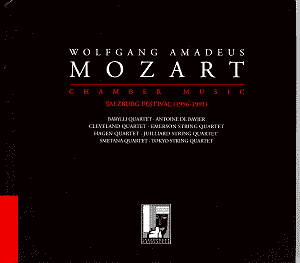This special commemorative
edition of Mozart chamber music from
the Salzburg Festival during the years
1956-1991 – mirroring two hundred years
later the span of Mozart’s own life
– comes in the form of a beautifully
presented small hardback volume. The
three CDs in envelopes are neatly bound
inside the front and back covers. The
rest of the contents include a note
by the producer Gottfried Kraus, an
article on Mozart’s chamber music by
the American critic Harry Haskell, and
a biographical note on the composer
from the New Grove. This last has no
author’s name, which is curious, since
all the on-line articles on the Grove
web-site are credited, and the "GroveMusic"
logo appears on the cover of this issue.
Be that as it may, all of this appears
in three languages, interspersed with
photographs of the featured quartets
(though unfortunately not of clarinettist
Antoine de Bavier), of Mozart, of the
Salzburg Mozarteum etc.
The performances are
of course live, and one could forgive
the most experienced musicians for being
somewhat overwhelmed at finding themselves
in the Grosser Saal of the Mozarteum.
There are many signs of ‘nerves’ – the
Smetanas sound undeniably tight at the
start of K.428, though they soon relax
and give an assured and highly musical
reading, characterised by that famous
golden tone, even in fortes.
The Andante is warmly expressive,
stylistically very much of its time,
with a pronounced legato that
sometimes edges towards portamento.
The wit and elegance of the Minuet and
Trio is superbly caught, while the final
Allegro vivace has just the right
restless energy.
The Barylli Quartet
performed for a relatively short time
as such – from 1951-1960. They appear
here with clarinettist Antoine de Bavier,
later better known as a conductor, who
not only has no photograph but is omitted
from the biographical notes too, which
seems a pity. Their Clarinet Quintet
begins unbelievably slowly, and de Bavier’s
first entry is tentative and insecure.
Things from there on don’t improve much,
and generally this is a languid, even
torpid performance, that never develops
any true life or inner momentum. De
Bavier is not helped by the balance,
which puts him at a disadvantage to
his string colleagues. This is unfortunate,
as most of the recordings are outstandingly
good.
Much finer is the Emerson
Quartet from the USA, recorded here
in 1990 playing K.464 in A. This quartet
is unusual in having its Minuet and
Trio second in the order of movements,
and the Emersons bring out the chromatic
intensity of this and other movements
well. Their playing is suavely confident,
with an enviable inner understanding
and deep security of ensemble. Some
may find their attack somewhat heavy,
even savage, in places. Yet this third
of Mozart’s so-called ‘Haydn Quartets’
is a forthright and robust work, which
I believe responds well to the Emerson’s
emphasis on textural and dynamic contrast.
For example, their use of senza vibrato
(i.e. the instruments are played
without using the customary vibrato
technique) in the return to simple
four-part harmony in the middle of the
Andante, contrasting with the
more complex writing on either side,
is, to me, strikingly effective.
Haydn’s famous words
of 1785 to Leopold Mozart – "your
son is the greatest composer I know
either personally or by repute"
– may seem almost like faint praise
from our modern perspective. But Mozart
himself would certainly not have felt
that. Such an endorsement from his world’s
greatest living musician would have
been immensely warming and encouraging.
No doubt Haydn was flattered by Mozart’s
clear adoption of many of his methods
in these quartets, and he returned the
compliment in many musical ways, such
as the Representation of Chaos in
his Creation, influenced by the
dark chromatic harmonies of the introduction
to the Dissonance Quartet, K.465,
here played by the Tokyo Quartet in
a recording from 1986. The contrast
with the Emersons is interesting and
welcome, the Japanese ensemble playing
less forcefully and in a generally less
extrovert way. This is in keeping with
the character of the piece, which is
a far more ‘inward’ work in many ways
than K.464, though the finale is a blithe
movement where the clouds eventually
seem to blow away, and the Tokyos give
a delightfully busy performance of this.
CD3 opens with the
Juilliard Quartet playing K499, the
"Hoffmeister" Quartet. This
settles into another fine performance,
once one has got over the shock of a
truly horrendous viola entry near the
beginning. A rather laboured Minuet
and Trio (again second in the running
order as in K.464) is followed by the
passionate Adagio, which is tackled
with great warmth, despite tiny imperfections
of ensemble and intonation here and
there – the sort of things that are
bound to happen in live performances.
The quirky finale, starting out almost
as an improvisation, gets a sharply
characterised reading, though the internal
balance of the quartet is not always
ideal; hard to tell if this is the playing
or the recording, and it’s possibly
a bit of both.
We then have a reading
from 1985 by the Cleveland Quartet of
that short masterpiece the Adagio
and Allegro K.546, better known
in its version for string orchestra.
The Adagio takes the chromaticism found
in the introduction to the Dissonance
several stages further, and here,
as in the Fugue, the Clevelands play
with disciplined intensity.
The final item of this
mouth-watering issue is, appropriately,
Mozart’s final quartet, K.590 in F,
played by the Hagen Quartet in 1991,
making this also the latest of the recordings.
This is a most extraordinary work, in
the equality with which it treats the
four members of the quartet, in the
harmonic language and in the rigour
of its motivic development (most of
all in the wonderfully witty and unpredictable
finale), which points clearly towards
Beethoven.
An issue, then, which
has been lovingly presented and prepared,
and which is packed with rare musical
pleasures.
Gwyn Parry-Jones
